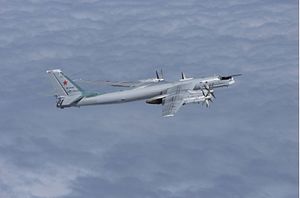Japan’s Ministry of Defense (MoD) reports that two nuclear-capable Russian Tupolev Tu-95MS strategic bombers have violated the country’s airspace off the Japanese island of Minamidaitō southeast of Okinawa and off Hachijō island in the Philippine Sea on June 20.
According to the MoD, a total of three Tu-95MS bombers conducted a long-range patrol along the eastern and western rims of the Japanese archipelago circumventing all major islands — Hokkaido, Honshu, Shikoku, and Kyushu–in the course of the flight.
It is unclear whether the Russian bombers were accompanied by fighter aircraft during today’s long-range aerial patrol. Given the distance flown it is likely that the Tu-95MSs received midair refueling while on their mission.
Japan Air Self Defense Force (JASDF) reportedly scrambled fighter jets to intercept the Russian military aircraft. In response to the Japanese allegations, the Russian MoD claimed later that there were no border violations during the flight operation.
Russian strategic bombers periodically circumvent the Japanese archipelago during long-range patrols. Russia only resumed regular long-range aerial patrols in East Asia in 2014 following an over a decade-long hiatus that began in the 1990s.
The Russian MoD usually refers to these flight operations as “routine flights” conducted in “strict accordance with international rules of using airspace, without any violations of the borders of other countries.”
The last reported violation of Japanese airspace by a Russian military aircraft took place in September 2015 off the South Kuril Islands, located in the Sea of Okhotsk in the Northwest Pacific. The island chain has been subject to a long-standing territorial dispute between Russia and Japan.
The JASDF conducted 343 scrambles against Russian military aircraft in fiscal year 2018, which ended this March. This constitutes a decline in comparison to fiscal year 2017, when the service scrambled fighter jets to intercept Russian military planes 390 times.
In February 2019, JASDF fighters intercepted four Tu-95MS strategic bombers and four Sukhoi Su-35S (Flanker-E+) multirole fighter jets flying in two separate formations over the east and west coasts of Japan.
The last reported JASDF scramble against Russian military took place on May 3 when two Tupolev Tu-142MZ maritime reconnaissance and anti-submarine warfare aircraft, conducting a long-range patrol in the Sea of Japan and East China Sea, were intercepted by Japanese fighter jets.
The increased Russian operational tempo in East Asia has led to a number of accidents this year.
“A pair of Su-34 fighter-bombers crashed into the Sea of Japan after reportedly colliding with each other off the coast in Russia’s Far East on January 18 (…),” I reported in February of this year.“Additionally, a Russian Air Force Tupolev Tu-22M3 supersonic bomber crashed at Olenegorsk airbase, in Russia’s northwestern region of Murmansk killing three crew members, on January 22.”
The Tu-95MS is an improved version of the older Tu-95, a Soviet-era four-engine, long-range, turboprop, strategic bomber that can be armed with stand-off missiles including the Kh-101/Kh-102 (nuclear variant) air-launched cruise missile or the Kh-55 subsonic air-launched cruise missile.

































